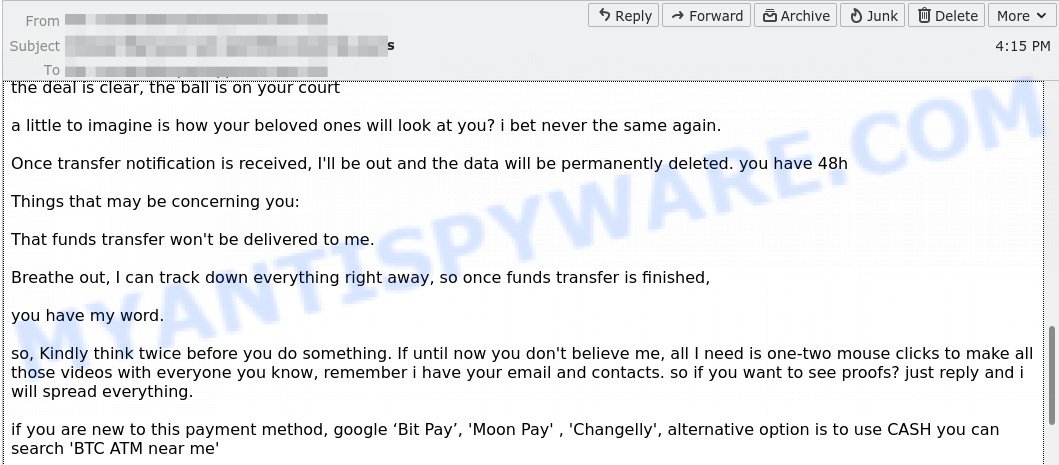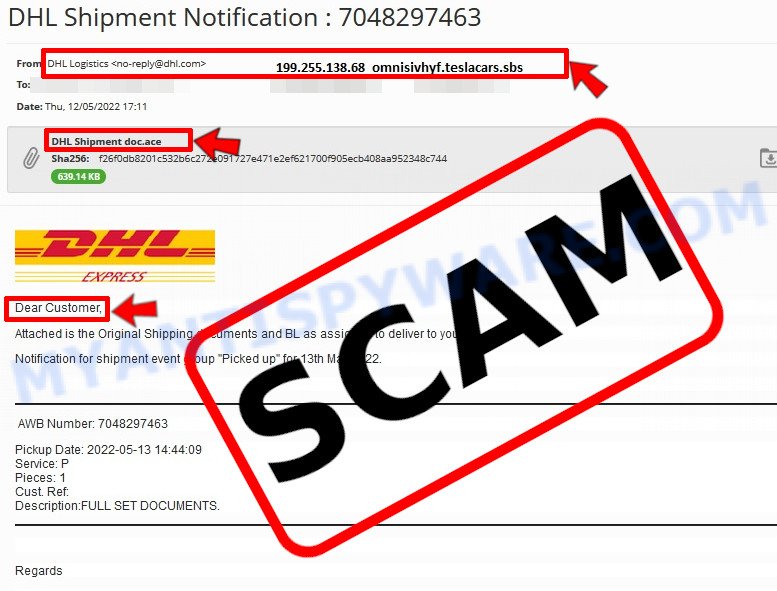⚠️ We looked at the email from someone calling themselves “LAZRUS”, and it’s clearly a scam trying to scare you into paying money. This scam is known as a “sextortion” email, where scammers claim to have embarrassing videos of you and ask for Bitcoin to keep quiet.

At first, the email might seem real and scary because it mentions your email address and tries to make you panic. But there are some things to keep in mind. These scammers usually don’t have any real evidence or videos; they just try to scare you with threats. Also, the Bitcoin wallet address 1N4JMGxbqpu8EuBeLkAfXjmGbP18VUxDiv they give is typical in these scams, as they prefer untraceable payments.
This type of scam is often sent out to thousands of people hoping someone will pay. They want $1,200 in Bitcoin, which is a trick to steal your money. They may threaten to send fake embarrassing videos or contacts to people you know, but they usually do nothing after payment.
💡 To protect yourself from scams like this:
– Don’t reply to the email or send any money.
– Don’t click on any links or download anything.
– Change your email and account passwords to be safe.
– Use two-factor authentication where you can.
– If you feel stressed, talk to someone you trust or report the email to your email provider.
Remember, scammers want to scare you into paying fast, but staying calm and not responding is the best way to handle this.
A typical “I know that your are and this email is yours” scam email reads as follows:
hello there
I know that your are and this email is yours
You might be wondering how I know this.
let me get straight to my point, a while ago i managed to access to your device and from there i spread myself across all the devices.
during this period i have managed to collect your internet history, and captured webcam footage of you playing with yourself while watching high controversial genre adult movies. ( with audio of course )
we both know what i’am talking about.
I believe you are starting to understand the gravity of this situation. I am sure your family, colleagues, and all your contacts would be interested in joining me to watch such disgraceful footage. My initial plan was to release this data and expose this side of you, which cannot be undone. However, I am not that kind of person.
Here is the deal: a small payment to save a reputation that has taken years to build.
transfer exactly $1200 worth of bit.coins to the wallet below.
For security purposes, the address is split into two parts that you need to combine:
(Merge both parts to get the full address: 1N4J********Div. This is how it should look before sending.)
part 1 : 1N4JMGxbqpu8EuBeLk
part 2 : AfXjmGbP18VUxDiv– make sure you are sending BTC ONLY !
– Use COPY & PASTE. Do not type the wallet address.the deal is clear, the ball is on your court
a little to imagine is how your beloved ones will look at you? i bet never the same again.
Once transfer notification is received, I’ll be out and the data will be permanently deleted. you have 48h
Things that may be concerning you:
That funds transfer won’t be delivered to me.
Breathe out, I can track down everything right away, so once funds transfer is finished,
you have my word.
so, Kindly think twice before you do something. If until now you don’t believe me, all I need is one-two mouse clicks to make all those videos with everyone you know, remember i have your email and contacts. so if you want to see proofs? just reply and i will spread everything.
if you are new to this payment method, google ‘Bit Pay’, ‘Moon Pay’ , ‘Changelly’, alternative option is to use CASH you can search ‘BTC ATM near me’
At the end i would like to express that it was nice meeting you and looking forward to doing business with you.
Always remember do not try to be hero.
Best regards,
LAZRUS
🕵️♂️ How the “I know that your are and this email” Email Scam Operates
“I know that your are and this email” scam is a type of extortion phishing email attack. 🚨 It tricks victims into paying ransom by threatening to expose fabricated compromising videos and personal information.
🔗 Step-by-Step Breakdown of the Scam:
📧 Email Targeting and Personalization
Scammers send threatening emails claiming they have hacked the victim’s devices and collected damaging footage and personal data. The email references the recipient’s email address and their internet history to increase the sense of legitimacy and fear.
🕸️ Crafting Threatening Messages
The message is carefully written to pressure the victim, describing embarrassing situations (e.g., watching adult content) to provoke panic. The attacker claims to have secret recordings including video and audio, intensifying the emotional manipulation.
💰 Demanding Cryptocurrency Payment
Victims are asked to pay a ransom (e.g., $1200) exclusively in Bitcoin, using a wallet address split into two parts to avoid detection and complicate tracking. Instructions emphasize copying the wallet address to prevent errors.
⏳ Creating Urgency and Fear
The scam features a tight deadline—typically 48 hours—warning that failure to pay will result in exposure to family, friends, and colleagues. The attacker plays on fear of reputational damage and social embarrassment.
👻 Using Fake Technical Claims
The scammer asserts they have compromised all devices linked to the victim’s email and can contact everyone in their address book, although this is almost always false. This is intended to intimidate the recipient into compliance.
🌐 Complicating Verification
No verifiable evidence accompanies the email; the threat remains unproven but believable enough to coerce victims who don’t verify or realize it is a bluff.
🚫 Lack of Genuine Communication
If victims respond or seek proof, scammers typically escalate threats or ignore the requests, continuing to pressure the victim but providing no actual proof of claims.
⚠️ Avoiding Law Enforcement and Detection
By demanding cryptocurrency, scammers avoid traditional banking systems, making transactions difficult to trace and reverse. Splitting wallet addresses and instructing victims to use specific payment channels further obfuscates their trail.
In summary, the LAZRUS extortion scam leverages fear, fabricated evidence, and urgency to coerce victims into paying significant amounts in cryptocurrency. The scam involves no real evidence or actual device hacks, but it relies heavily on emotional manipulation and threats to extort money. Victims are advised to ignore such emails, avoid payment, and report the incidents to appropriate cybersecurity authorities.
Summary Table
| Name | “I know that your are and this email is yours” email |
| Type | Email extortion and blackmail |
| Threat | Claims of hacked device, webcam recordings, and exposing personal activities |
| Demand | $1200 in Bitcoin |
| Bitcoin Wallet Address | 1N4JMGxbqpu8EuBeLkAfXjmGbP18VUxDiv |
| Deadline | 48 hours |
| Scammer’s Signature | LAZRUS |
📧 What to Do When You Receive the “I know that your are and this email is yours” Scam Email
We advise everyone who receives this email to follow the simple steps below to protect yourself from potential scams:
- ❌ Do not believe this email.
- 🔒 NEVER share your personal information and login credentials.
- 📎 Do not open unverified email attachments.
- 🚫 If there’s a link in the scam email, do not click it.
- 🔍 Do not enter your login credentials before examining the URL.
- 📣 Report the scam email to the FTC at www.ftc.gov.
If you accidentally click a phishing link or button in the “I know that your are and this email is yours” Email, suspect that your computer is infected with malware, or simply want to scan your computer for threats, use one of the free malware removal tools. Additionally, consider taking the following steps:
- 🔑 Change your passwords: Update passwords for your email, banking, and other important accounts.
- 🛡️ Enable two-factor authentication (2FA): Add an extra layer of security to your accounts.
- 📞 Contact your financial institutions: Inform them of any suspicious activity.
- 🔄 Monitor your accounts: Keep an eye on your bank statements and credit reports for any unusual activity.
🔍 How to Spot a Phishing Email
Phishing emails often share common characteristics; they are designed to trick victims into clicking on a phishing link or opening a malicious attachment. By recognizing these signs, you can detect phishing emails and prevent identity theft:

💡 Here Are Some Ways to Recognize a Phishing Email
- ✉️ Inconsistencies in Email Addresses: The most obvious way to spot a scam email is by finding inconsistencies in email addresses and domain names. If the email claims to be from a reputable company, like Amazon or PayPal, but is sent from a public email domain such as “gmail.com”, it’s probably a scam.
- 🔠 Misspelled Domain Names: Look carefully for any subtle misspellings in the domain name, such as “arnazon.com” where the “m” is replaced by “rn”, or “paypa1.com”, where the “l” is replaced by “1.” These are common tricks used by scammers.
- 👋 Generic Greetings: If the email starts with a generic “Dear Customer”, “Dear Sir”, or “Dear Madam”, it may not be from your actual shopping site or bank.
- 🔗 Suspicious Links: If you suspect an email may be a scam, do not click on any links. Instead, hover over the link without clicking to see the actual URL in a small popup. This works for both image links and text links.
- 📎 Unexpected Attachments: Email attachments should always be verified before opening. Scan any attachments for viruses, especially if they have unfamiliar extensions or are commonly associated with malware (e.g., .zip, .exe, .scr).
- ⏰ Sense of Urgency: Creating a false sense of urgency is a common tactic in phishing emails. Be wary of emails that claim you must act immediately by calling, opening an attachment, or clicking a link.
- 📝 Spelling and Grammar Errors: Many phishing emails contain spelling mistakes or grammatical errors. Professional companies usually proofread their communications carefully.
- 🔒 Requests for Sensitive Information: Legitimate organizations typically do not ask for sensitive information (like passwords or Social Security numbers) via email.
Conclusion
The “I know that your are and this email is yours” Email Scam is a fraudulent scheme designed to scare and deceive recipients by claiming unauthorized access to their devices and threatening to release supposed compromising footage. The scammers use intimidating language and fabricated details to pressure victims into sending ransom payments in Bitcoin.
This scam relies entirely on fear and manipulation, with no real evidence or capability to access your personal data. They often spoof your email address or use public information to make their threats seem credible. The claims about capturing webcam footage or internet history are baseless and are intended solely to provoke anxiety.
Bottom Line: Do not respond to or pay any ransom demands from the LAZRUS scam email. Instead, mark the message as spam, delete it, and ensure your online accounts and devices are secured with strong passwords and updated software. Always remain vigilant against such extortion schemes and educate yourself on how to spot fake threats.
Remember, paying the scammer does not guarantee safety or privacy and may expose you to further targeting. Stay calm, report the incident to the appropriate authorities, and protect your digital security proactively.

















